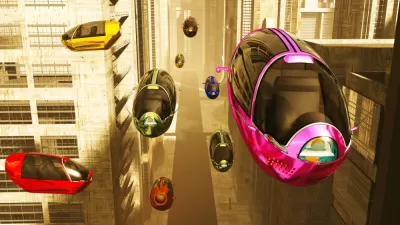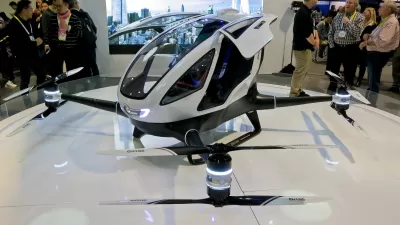The hulking structures proposed to handle UberAIR's fleet of flying taxis won't be able to serve 4,000 passengers per hour. And that's just one of their many deficiencies, Alissa Walker writes.

Alissa Walker excoriates a set of designs for the "skyports" Uber wants to install in cities to serve UberAIR, its ambitious plan to make autonomous flying taxis a reality. "As they stand now, these hulking structures are essentially just freeway ramps—limited capacity, car-centric infrastructure that would take up a lot of space in our cities but serve only one purpose—and even getting them to work as well as existing freeways will be challenging."
Walker goes through a laundry list of criticisms, beginning with the steep logistical challenges involved. Furthermore, she writes, "this is clearly car-centric infrastructure, even if it's all about the air. Because you will be getting to the UberAIR terminal via your Uber car, of course." The plans tend to locate the hulking skyports next to or over existing freeways.
Another problem: "many of [the designs] appear to be the tallest building in the neighborhoods they serve, and god bless any architect who believes he might be able to convince a homeowners' association on LA's lawsuit-happy Westside to build a small airport on top of a brand-new skyscraper."
Should they ever become a reality, "Uber's skyports should be places that provide a myriad of additional benefits for neighborhoods—and don't create any additional car trips." Of course, this idea is still in its earliest stages, and Uber hasn't yet settled on what kind of VTOL (vertical takeoff and landing) aircraft would work here, if any.
FULL STORY: Uber’s Skyports are just freeway onramps for flying cars

Trump Administration Could Effectively End Housing Voucher Program
Federal officials are eyeing major cuts to the Section 8 program that helps millions of low-income households pay rent.

Planetizen Federal Action Tracker
A weekly monitor of how Trump’s orders and actions are impacting planners and planning in America.

Ken Jennings Launches Transit Web Series
The Jeopardy champ wants you to ride public transit.

Rebuilding Smarter: How LA County Is Guiding Fire-Ravaged Communities Toward Resilience
Los Angeles County is leading a coordinated effort to help fire-impacted communities rebuild with resilience by providing recovery resources, promoting fire-wise design, and aligning reconstruction with broader sustainability and climate goals.

When Borders Blur: Regional Collaboration in Action
As regional challenges outgrow city boundaries, “When Borders Blur” explores how cross-jurisdictional collaboration can drive smarter, more resilient urban planning, sharing real-world lessons from thriving partnerships across North America.

Philadelphia Is Expanding its Network of Roundabouts
Roundabouts are widely shown to decrease traffic speed, reduce congestion, and improve efficiency.
Urban Design for Planners 1: Software Tools
This six-course series explores essential urban design concepts using open source software and equips planners with the tools they need to participate fully in the urban design process.
Planning for Universal Design
Learn the tools for implementing Universal Design in planning regulations.
Ada County Highway District
Clanton & Associates, Inc.
Jessamine County Fiscal Court
Institute for Housing and Urban Development Studies (IHS)
City of Grandview
Harvard GSD Executive Education
Toledo-Lucas County Plan Commissions
Salt Lake City
NYU Wagner Graduate School of Public Service




























